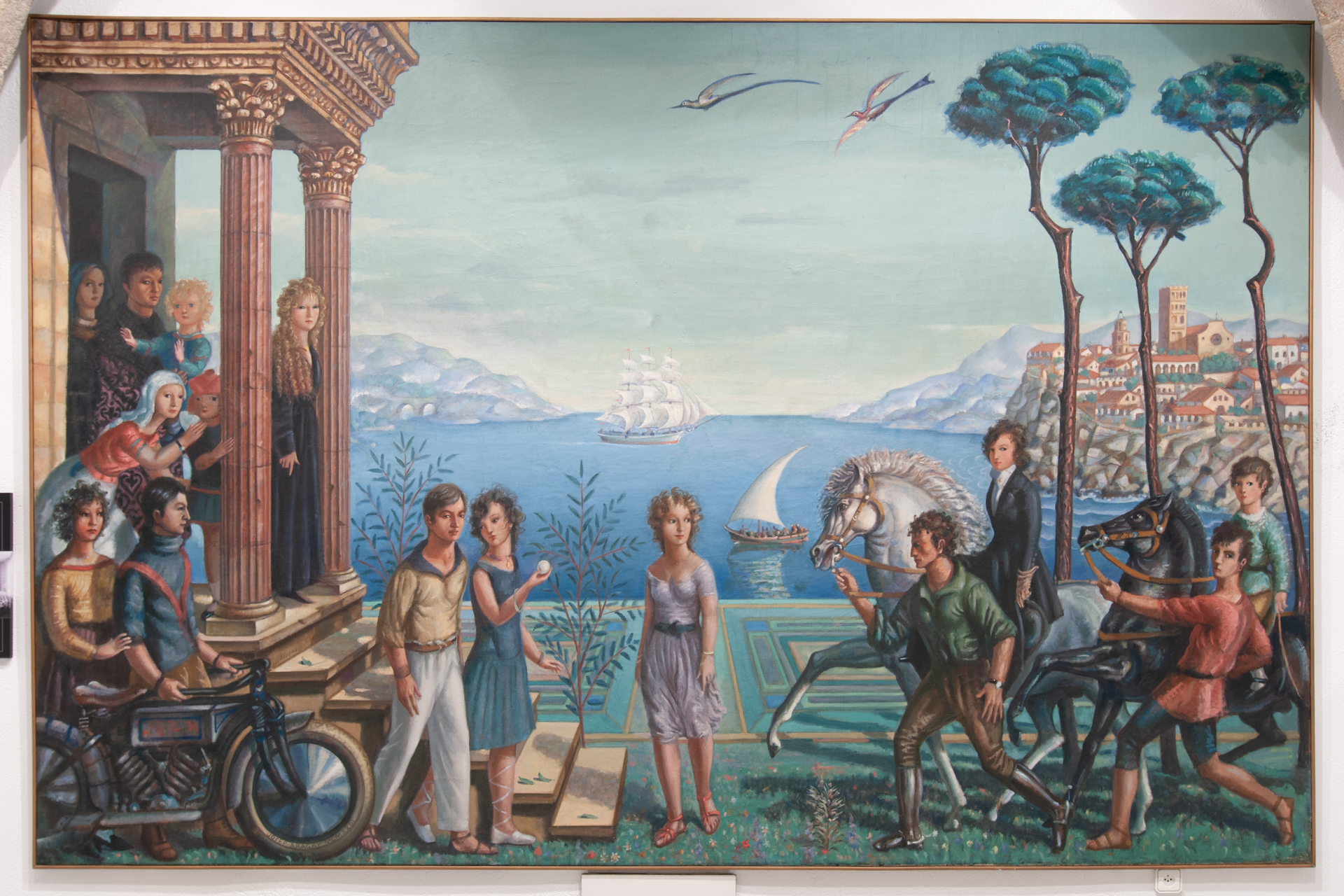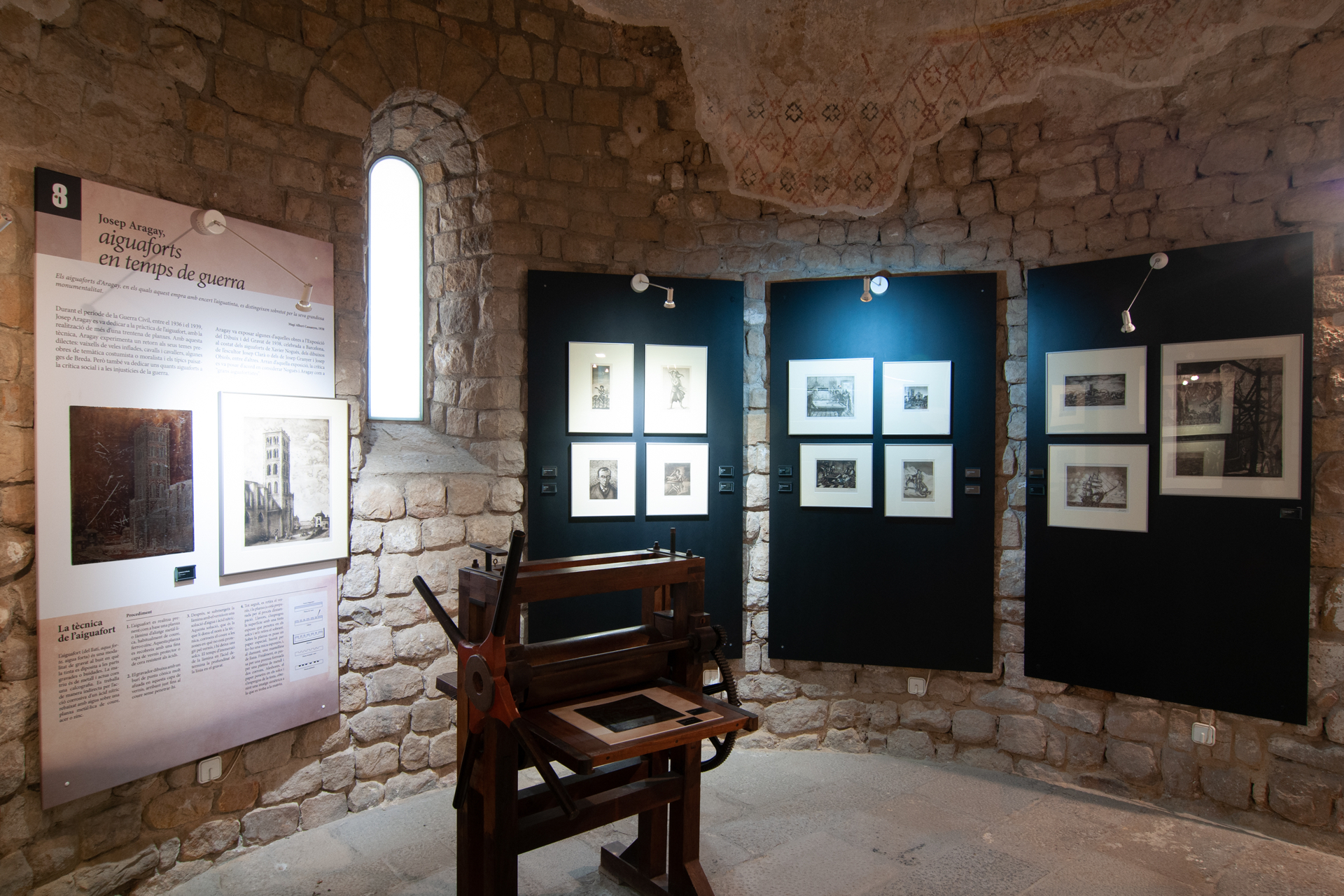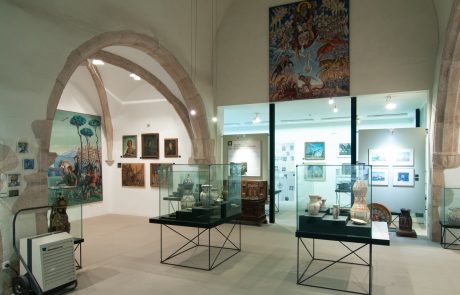MUSEUM
Founded in 1974, the Josep Aragay Municipal Museum in Breda is located in the old 12th-century Church of Santa Maria. Dedicated exclusively to the artist of the Noucentisme movement, Josep Aragay i Blanchar (Barcelona 1889 – Breda 1973), the museum contains a large collection of paintings, ceramics, drawings and etchings.
BIOGRAPHY
ARAGAY I BLANCHAR, Josep
(Barcelona 1889 – Breda 1973)
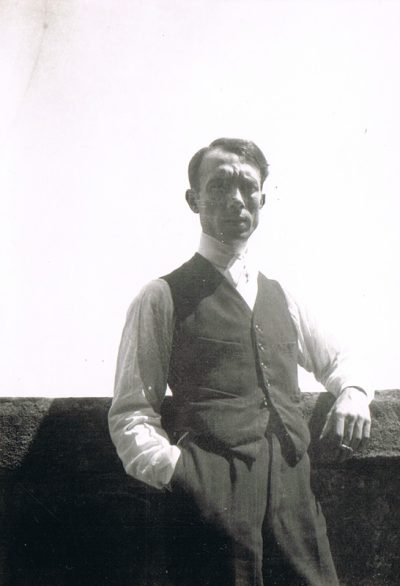
Josep Aragay i Blanchar was one of the leading figures of recent Catalan culture. An illustrator, etcher, painter and ceramist, he was also a poet, teacher and politician, as well as an active and influential critic, debater and art theorist.
In May 1906, the young Aragay had his first joke published in the children’s comic En Patufet. As such, Josep Aragay took his first steps in the country’s artistic scene just as Catalunya was ushering in one of the most important periods of cultural and political renewal of our history: Noucentisme.
Earning renown as an illustrator, in 1908, at the weekly satirical magazine Papitu –under the pseudonym Jacob–, from the very beginning, he was one of the ndriving forces behind many of the cultural initiatives and enterprises related to the Noucentist project. As a result, in 1911, Eugeni d’Ors entrusted him with the artistic supervision of L’Almanach dels Noucentistes, while, a year later, he founded the magazine Picarol. Aragay also continued to contribute to other satirical magazines, such as Cuca-Fera (1917) and Borinot (1923).
After years studying at the art academy of Francesc d’Assis Galí (1907-1911), he joined the association Les Arts i els Artistes and began exhibiting his work at the leading galleries in Barcelona. Aragay’s reputation continued to grow and his energetic, temperamental style of painting was discussed in the main newspapers and magazines of the time. However, Aragay’s standing within the country’s art scene took a huge leap forward when he decided to specialise in ceramics, a discipline that fascinated him and which he had learned under the tutelage of Francesc Quer. From 1915 onwards, he gave his first exhibitions and became a pioneer in the world of decorative ceramics.

In 1916, he published his first article, entitled “Contemporary Catalan painting. Its heritage and legacy”. The same year, thanks to a grant awarded to him by Barcelona City Council, he travelled to Italy, primarily to study the mural paintings of the grand Masters of the Renaissance. This trip would have an unprecedented impact on him. Over the course of nine months, he visited Genoa, Pisa, Florence, Siena, Orvieto, Gaeta, Naples, Pompeii, Rome, Assisi, Perugia and Arezzo.
Aragay kept a diary of his travels of great artistic and literary value, which remained unpublished until many years after his death. The exhibitions that he did after his trip and the five ceramic panels he made for the Santa Anna Fountain in Barcelona clearly demonstrate a change in artistic direction, embracing the simplicity, sobriety and harmony of Classicism.
On his return from Italy, he launched an intensive and radical offensive to instil the ethical and aesthetics of Classicism in Catalonia, as well as to combat all manifestations of avant-garde art As part of this mission, he wrote articles in La Publicitat, La Revista, and L’Instant. He also published the book of poetry “Italia” (1918) and gave and published speeches such as “The Nationalism of Art” (1920). Faithful to his ideas, Aragay made a name for himself as one of the most controversial and unyielding theorists of the time.
In 1923, he painted the most iconic work of his career “Vacances” (Holidays”), which he conceived as a true embodiment of Noucentisme. Exhibited in 1924 at the Laietanes Galleries in Barcelona, the painting triggered a huge controversy and lots of negative criticism. The same year, he was dismissed from the Escola Superior de Bells Oficis (Advanced College of Artisan Crafts), along with other teachers, due to the Dwelshauvers affair, one of the most shameful episodes of the dictatorship of Primo de Rivera. The College, where Aragay had taught Graphic Studies of Ceramics and Projects since 1918, was closed down. The whole situation led Aragay to leave Barcelona and move to Breda, his mother’s hometown, which has a strong tradition of pottery and where he had spent his summers since childhood.
In Breda, he did the only al fresco painting in his career, in the baptistery of the Gothic Church of Santa Maria. It was also in Breda that, in 1925, he opened a ceramics workshop. Aragay combined decorative ceramics, creating unique signature pieces that were very popular in various exhibitions, and top-quality industrial pottery that was sold all over the country.

During the Civil War, Aragay had to halt production of ceramics and he turned his attention to the art of etching. Towards the end of the War, the frescos he had painted in the church were destroyed in a fire. After the conflict, the artist was arrested and jailed for having been a councillor on Breda Town Council during the years of the second Republic. His wife, Teresa Solà, a children’s teacher in the town and strong advocate of Catalan independence, was also imprisoned. In 1941, Josep Aragay was released on bail and Teresa Solà was banned from teaching. Their status as “disaffected rebels” made their social life and earning a living difficult.
When Aragay decided to begin painting again, it was very hard to find galleries willing to exhibit his work. Magazines and newspapers also refused to publish his illustrations and articles. This hardship was compounded even further by an insurmountable obstacle: Aragay’s resolute advocacy of the old styles and convictions, and his refusal to make any concessions to modern painting whatsoever. Stuck in the past, his work contrasted starkly with the new ideas of the young artists spearheading artistic progress in our country. All these factors forced Aragay to distance himself from the exhibition circuit, leading to an end to criticism of his work and a decline into obscurity among futures generations. He died in Breda in January 1973 and, the following year, the museum bearing his name was opened, dedicated exclusively to his work.
Xavier Castanyer i Angelet
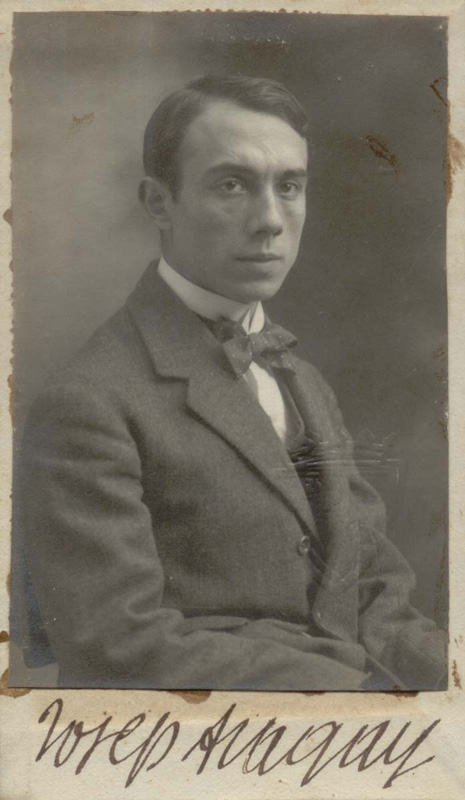

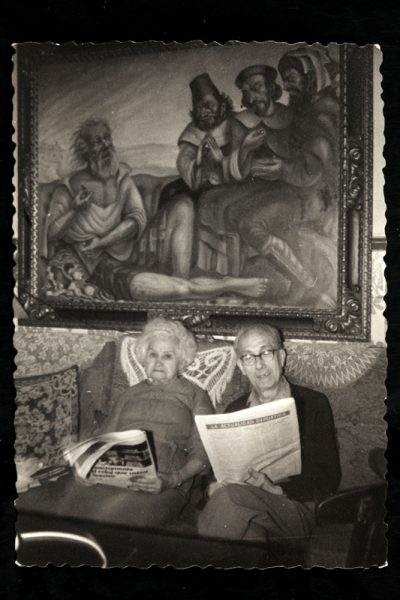
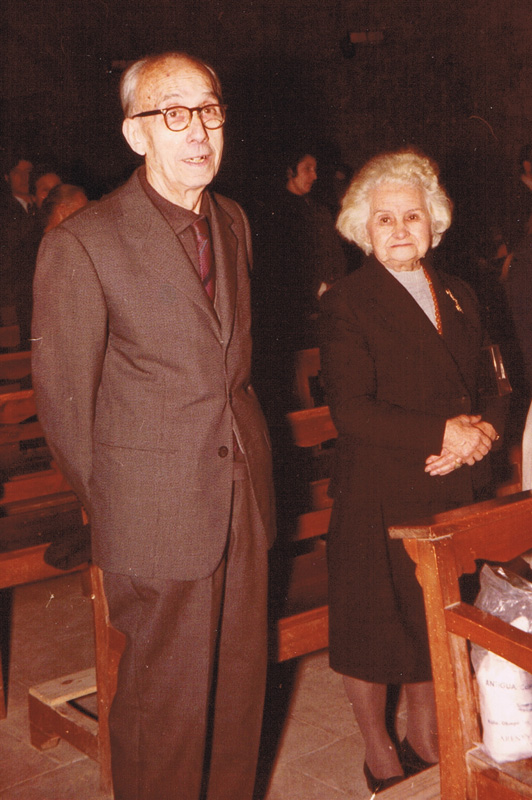

EXHIBITION
TIMELINE
Josep Aragay i Blanchar, 1889-1973
1889
Josep Aragay i Blanchar is born on 3rd August in Carrer del Carme in Barcelona, near to the Church of Bethlehem. The son of Florenci Aragay, a tailor from Cànoves, and Rosa Blanchar, a seamstress from Breda. The couple have three children: Jaume, Modest and Josep.
1895
He discovers his vocation as an illustrator very early on: “Favourite toy: a pencil”. During the holidays, the Aragay spent long periods in Breda, his mother’s hometown.
1906
At just sixteen years old, his first illustrations are published in the children’s comic En Patufet. The illustrator Gaietà Cornet is his role model. He also works with the satirical magazine Cu-cut!
1907
He enrols at La Llotja School, which he leaves the same year to join the art academy of Francesc d’Assís Galí. He visits the 5th International Exhibition of Fine Art and Artistic Industries in Barcelona, where he is impressed by the work of the Belgian-born Welsh painter Frank William Brangwyn.
1908
He builds his reputation as an illustrator in the satirical magazine Papitu, under the pseudonym of Jacob until 1911.
1910
His mentor, Francesc d’Assís Galí, describes Josep Aragay as his “most promising student, with the highest artistic conditions” of all his proteges. On 24th May, he displays his work in an exclusive exhibition in the Casa Reig in Barcelona (Passeig de Gràcia 27).
1911
Eugeni d’Ors entrusts him with the artist supervision of L’Almanach dels Noucentistes, the great manifesto of Noucentisme published by Joaquim Horta. Together with Francesc Pujols, he becomes a member of the association Les Arts i els Artistes, and begins to exhibit his work in the group’s exhibitions. He is awarded the third medal (illustration section) at the 6th Barcelona International Art Exhibition, held at the Palau de Belles Arts. His work is shown at the Sala Clarà gallery in Barcelona alongside Joaquim Torres-Garcia and the sculptor Josep Clarà. He illustrates the cover of the book “Poemes del Port” by Josep Maria López-Picó. He works as an illustrator on the magazine Ciutat de Terrassa.
1912
With Xavier Nogués and Manuel Humbert, he founds and directs the humorous magazine Picarol, edited by Santiago Segura and considered one of the best-produced magazines of its kind in Europe.
1913
A large exhibition exclusively of his work at the Dalmau Galleries in Barcelona (Portaferrissa 18), runs from 12th to 30th April, generating a lot of interest in the press.
At the inauguration of the Sala Athenea gallery in Girona, Aragay exhibits his work alongside Rusiñol, Llimona, Mir, Torres-Garcia, Regoyos, Togores, Galí and other artists.
1914
He founds the Guild of Applied Arts, with Francesc Galí, Xavier Nogués, Ramon Reventós, Francesc Canyellas, Francesc Labarta and Jaume Llongueras. Under the tutelage of Francesc Quer, he learns the trade of ceramics. He works as an illustrator on the magazine Revista Nova.
1915
Ceramics exhibitions with Francesc Quer, first at La Cantonada and then at the Laietanes Galleries in Barcelona (Gran Via 613), with great public success and good critiques in the press. He publishes a number of articles in the magazine Vell i Nou. He gives his first conference, entitled “Contemporary Catalan painting. Its heritage and legacy” at the Exhibition of New Catalan Art in Sabadell, which includes pieces of his work. He illustrates the cover of the book “Poemes de Neguit”, by Joaquim Folguera, and contributes to the magazine Ibèria as an illustrator.
He takes an active part in the discussion groups at Cafè Continental in Barcelona, alongside Josep M. López-Picó, Carles Riba, Clementina Arderiu, Josep Benet, Joan Crexells, Martí Casanova, Joaquim Folguera, Josep Millàs-Raurell, Tomàs Garcés, J.V. Foix, Josep Obiols, Xavier Nogués, Agustí Esclasans and Josep Maria Junoy, among others.
1916
A large exhibition exclusively of his paintings at the Laietanes Galleries in Barcelona. His Sabadell, conference “Contemporary Catalan painting. Its heritage and legacy” is published by Publicacions de La Revista, as Aragay’s first essay. He contributes the magazine Revista Nova as an illustrator.
Thanks to the influence of Jaume Bofill i Mates, he receives a grant from Barcelona City Council to travel to Italy study the processes involved in mural painting. On 12th April, in the midst of the First World War, he boards a train to Genoa, his starting point of his tour around the country.
1917
He returns to Barcelona after a very rewarding nine-month trip around Genoa, Pisa, Florence, Siena, Orvieto, Gaeta, Naples, Pompeii, Rome, Assisi, Perugia and Arezzo.
The Development Commission of Barcelona City Council commissions him to oversee the restoration of the Gothic fountain in Plaça de Santa Anna. He begins to publish art critiques, articles illustrations in the magazine La Revista. He is the head illustrator at the humorous magazine Cuca-Fera.
1918
Inauguration of the Fountain of Santa Anna, decorated with five ceramic panels and crowned with vases. The work was produced in collaboration with Francesc Quer. He teaches Graphic Studies of Ceramics and Projects at the Escola Superior de Bells Oficis (Advanced College of Artisan Crafts). He collaborates as an illustrator on Joan Salvat Papasseit’s magazine “Un enemic del poble” (“An enemy of the people”). Every year, he continues exhibiting his work as part of the group exhibitions of the association Les Arts i els Artistes. His book of poetry “Itàlia” is published by Les Publicacions de La Revista, with a foreword by Carles Riba.
1919
Xènius dedicates a verse to him entitled “Italiae sacra fames” (“Glosari”, La Veu de Catalunya, 12th May 1919). Inaugural exhibition of the Puig Gallery in Barcelona (Pelai 14), with a collection of frescos, illustrations and ceramics. He contributes to the French-Catalan magazine L’Instant.
1920
He writes “The Nationalism of Art”, a seminal essay of Noucentisme, published by Les Publicacions de La Revista. He gives a controversial conference entitled “The Roman Arch of Berà and the Catalan Legionaries” at the Ateneu Barcelonès, which is later published on the front cover of the newspaper La Publicidad. He takes part in the collective exhibition organized by Catalan artists for the first time in the Autumn Gallery in Paris. Josep M. López-Picó dedicates his book of poetry “El retorn” (Op. XII) to Aragay.
1921
He displays his work in Lisbon in a new collective exhibition of Catalan artists. Exhibition of ceramics and watercolours at the Laietanes Galleries.
1923
The launch of the weekly satirical magazine El Borinot, founded by Lluís Bertran i Pijoan and Aragay himself, who is also the head illustrator. He occasionally contributes to the children’s magazine La Mainada.
1924
A large exhibition exclusively of his work at the Laietanes Galleries, where the painting “Vacances” (“Holidays”) generates huge controversy and many negative critiques. He is dismissed from the Advanced College of Artisan Crafts, along with other teachers, due to the Dwelshauvers affair, one of the most shameful episodes of the dictatorship of Primo de Rivera. The College is closed down the same year. All this leads Aragay to leave Barcelona.
1925
Settled in Breda, he paints the frescos in the baptistery of the church and sets up a ceramics workshop. He decides to stop painting provisionally and focus his efforts fully on decorative ceramics. He leaves the magazine El Borinot. He displays photographs of the baptistery at the Exhibition of Liturgical Art held in November at the Sala Parés Gallery in Barcelona. Joan Salvat Papasseit’s book “Ossa Menor” is published posthumously, with a poem dedicated to Aragay “Nocturn per acordió” (“Nocturne for Accordion”).
1928
Exhibition of the ceramics produced at the Breda workshop at the Galeria dels Bells Oficis in Girona (Casa Busquets) (Rambla Àlvarez de Castro 7), from 28th October to 10th November. He occasionally contributes to the children’s magazine Jordi.
1929
He displays the painting “Vacances” at the Barcelona International Exhibition.
1930
Exhibition of ceramics at the Sala Parés Gallery in Barcelona, from 3rd to 16th May. The exhibition is very well received by the public and critics alike, and it earns a good revenue.
1931
He organizes another very successful exhibition at the Sala Parés Gallery in Barcelona, from 17th to 30th October. The architect F. Quintana commissions Aragay to decorate the lobby in the children’s section of the Anti-Tuberculosis Institute of the Caixa de Pensions bank in Barcelona. For the occasion, Aragay creates a series of seven panels with images for children. Conference on stoneware at the Association for the Promotion of Decorative Arts in Barcelona.
1932
He publishes articles in several newspapers and magazines: La Veu de Catalunya, Cerámica, Mirador and La Publicitat.
1934
He stands for the municipal election for the Catalan Republican Action party. He is elected as a councillor on Breda Town Council. Aragay in the deputy mayor, president of the Taxation Commission and representative of the Local Primary Education Council. As a result of the events of 6th October, he is arrested and sent to prison along with his colleagues on the council. In December, he marries Teresa Solà, who teaches children in the town.
Throughout the summer months and until the start of the war, Breda become a small Noucentist intellectual haven. The family of the painter Josep Obiols; the husband and wife poets, Carles Riba and Clementina Arderiu; the illustrator Miquel Cardona (Quelus); the artist Xavier Nogués and his wife Isabel Escalada, came to stay in Breda with Aragay and Solà.
1935
Aragay’s ceramics are presented at the Paris Exhibition Fair in the 1934 and 1935 editions. He also sells his work at the gallery founded by Baroness Laura T. Bucòvitx in Tossa de Mar which exhibits the work of foreign artists (André Mason, Marc Chagall, Jean Metzinger, etc.) taking refuge in this town in the county of La Selva in the inter-war period.
1936
With the victory of the Popular Front in the elections in February, Aragay and his colleagues on the council resumed their posts. When the Civil War erupts, the ceramics workshop closes down. Aragay focuses his artistic efforts almost exclusively on etching.
1938
With Xavier Nogués, Josep Clarà, Josep Obiols, Josep Granyer and other artists, he displays his etchings at the Illustration and Engraving Exhibition organized by the Catalan Government and held in the Exhibition Hall of the Casal de Cultura in Plaça de Catalunya in Barcelona.
1939
On 31st January, towards the end of the war, a fire in the church of Breda destroys the frescos pained by Aragay in the baptistery in 1925. After the war, Teresa Solà is banned from teaching. Shortly afterwards, Aragay and Solà are arrested and sent to prison. Josep Aragay is condemned for being a councillor during the Second Republic and Teresa Solà for her left-wing ideology.
1940
Josep Aragay serves his sentence in the Girona Seminary, which has been converted into a prison, while Teresa Solà is held at the Les Corts prison in Barcelona.
1941
Josep Aragay and Teresa Solà are released from prison on bail and confined to the town of Breda. Their status as “disaffected rebels” makes their social life and earning a living difficult.
1948
He starts painting again. He founds the BAT society (named after Bagué, Aragay and Trunas), dedicated to the production of pottery and the manufacture of utilitarian ceramics. However, Aragay only provides the workshop and the moulds, making little artistic or artisanal contribution.
1949
After getting through the bureaucracy of censorship, he manages to exhibit his work at the SYRA Galleries in Barcelona (Passeig de Gràcia). The exhibition goes by almost unnoticed.
1951
The ban on Teresa Solà from teaching is lifted and she is posted at a school in Sant Antoni de Vilamajor in the county of Vallès Oriental, where she will work until she retires in 1957 and where the couple will live for the last two years before her retirement.
1953
Josep Aragay writes the “Treatise on Drawing and Painting” which he never manages to publish. Neither is he able to publish other essays and poems that he writes during Franco’s dictatorship.
1961
At seventy two years old, he exhibits his work at the Sala Parés Gallery in Barcelona with a panoramic selection of his career, including some new paintings. The critiques describe Aragay as an artist of the past.
1965
Encouraged by friends, he paints a new baptistery in the church in Breda, using plastic paint on panels of synthetic wood that will be hung on top of the fresco that was burnt during the war. Still today, the 1925 frescos lay under the overlaid paintings from 1965 awaiting restoration.
1968
A retrospective exhibition is held to mark the nine hundredth anniversary of the Monastery of Sant Salvador in Breda. It is the last exhibition exclusively of Aragay’s during his lifetime, and a clear precursor of what, years later, would become the Josep Aragay Municipal Museum.
1970
He publishes “Jacob. Great Illustrators” (Editorial Taber), with a foreword by Maria Lluïsa Borràs and annotations by Josep Maria Cadena.
1971
The exhibition “Noucentisme and the Nineteen Twenties” is held at the Dau al Set Gallery in Barcelona, with a number of works by Aragay.
1973
Josep Aragay dies in Breda on 15th January.
1974
Thanks to the association Amics de Breda (Friends of Breda), chaired by Ramon Samon, the Josep Aragay Municipal Museum is founded, dedicated exclusively to the artist’s work. Marcel·lí Trunas, a personal friend of Aragay with great knowledge of his work, becomes the Director of the museum, a position he will hold until 2005.
Most notable individual exhibitions
MUSEUM
Founded in 1974, the Josep Aragay Municipal Museum in Breda is located in the old 12th-century Church of Santa Maria. Dedicated exclusively to the artist of the Noucentisme movement, Josep Aragay i Blanchar (Barcelona 1889 – Breda 1973), the museum contains a large collection of paintings, ceramics, drawings and etchings.
INFORMACIÓ
BIOGRAPHY
ARAGAY I BLANCHAR, Josep
(Barcelona 1889 – Breda 1973)

Josep Aragay i Blanchar was one of the leading figures of recent Catalan culture. An illustrator, etcher, painter and ceramist, he was also a poet, teacher and politician, as well as an active and influential critic, debater and art theorist.
In May 1906, the young Aragay had his first joke published in the children’s comic En Patufet. As such, Josep Aragay took his first steps in the country’s artistic scene just as Catalunya was ushering in one of the most important periods of cultural and political renewal of our history: Noucentisme.

Earning renown as an illustrator, in 1908, at the weekly satirical magazine Papitu –under the pseudonym Jacob–, from the very beginning, he was one of the ndriving forces behind many of the cultural initiatives and enterprises related to the Noucentist project. As a result, in 1911, Eugeni d’Ors entrusted him with the artistic supervision of L’Almanach dels Noucentistes, while, a year later, he founded the magazine Picarol. Aragay also continued to contribute to other satirical magazines, such as Cuca-Fera (1917) and Borinot (1923).
Seguir llegint
After years studying at the art academy of Francesc d’Assis Galí (1907-1911), he joined the association Les Arts i els Artistes and began exhibiting his work at the leading galleries in Barcelona. Aragay’s reputation continued to grow and his energetic, temperamental style of painting was discussed in the main newspapers and magazines of the time. However, Aragay’s standing within the country’s art scene took a huge leap forward when he decided to specialise in ceramics, a discipline that fascinated him and which he had learned under the tutelage of Francesc Quer. From 1915 onwards, he gave his first exhibitions and became a pioneer in the world of decorative ceramics.

In 1916, he published his first article, entitled “Contemporary Catalan painting. Its heritage and legacy”. The same year, thanks to a grant awarded to him by Barcelona City Council, he travelled to Italy, primarily to study the mural paintings of the grand Masters of the Renaissance. This trip would have an unprecedented impact on him. Over the course of nine months, he visited Genoa, Pisa, Florence, Siena, Orvieto, Gaeta, Naples, Pompeii, Rome, Assisi, Perugia and Arezzo. Aragay kept a diary of his travels of great artistic and literary value, which remained unpublished until many years after his death. The exhibitions that he did after his trip and the five ceramic panels he made for the Santa Anna Fountain in Barcelona clearly demonstrate a change in artistic direction, embracing the simplicity, sobriety and harmony of Classicism. On his return from Italy, he launched an intensive and radical offensive to instil the ethical and aesthetics of Classicism in Catalonia, as well as to combat all manifestations of avant-garde art As part of this mission, he wrote articles in La Publicitat, La Revista, and L’Instant. He also published the book of poetry “Italia” (1918) and gave and published speeches such as “The Nationalism of Art” (1920). Faithful to his ideas, Aragay made a name for himself as one of the most controversial and unyielding theorists of the time.

In 1923, he painted the most iconic work of his career “Vacances” (Holidays”), which he conceived as a true embodiment of Noucentisme. Exhibited in 1924 at the Laietanes Galleries in Barcelona, the painting triggered a huge controversy and lots of negative criticism. The same year, he was dismissed from the Escola Superior de Bells Oficis (Advanced College of Artisan Crafts), along with other teachers, due to the Dwelshauvers affair, one of the most shameful episodes of the dictatorship of Primo de Rivera. The College, where Aragay had taught Graphic Studies of Ceramics and Projects since 1918, was closed down. The whole situation led Aragay to leave Barcelona and move to Breda, his mother’s hometown, which has a strong tradition of pottery and where he had spent his summers since childhood.
In Breda, he did the only al fresco painting in his career, in the baptistery of the Gothic Church of Santa Maria. It was also in Breda that, in 1925, he opened a ceramics workshop. Aragay combined decorative ceramics, creating unique signature pieces that were very popular in various exhibitions, and top-quality industrial pottery that was sold all over the country.

During the Civil War, Aragay had to halt production of ceramics and he turned his attention to the art of etching. Towards the end of the War, the frescos he had painted in the church were destroyed in a fire. After the conflict, the artist was arrested and jailed for having been a councillor on Breda Town Council during the years of the second Republic. His wife, Teresa Solà, a children’s teacher in the town and strong advocate of Catalan independence, was also imprisoned. In 1941, Josep Aragay was released on bail and Teresa Solà was banned from teaching. Their status as “disaffected rebels” made their social life and earning a living difficult.
When Aragay decided to begin painting again, it was very hard to find galleries willing to exhibit his work. Magazines and newspapers also refused to publish his illustrations and articles. This hardship was compounded even further by an insurmountable obstacle: Aragay’s resolute advocacy of the old styles and convictions, and his refusal to make any concessions to modern painting whatsoever. Stuck in the past, his work contrasted starkly with the new ideas of the young artists spearheading artistic progress in our country. All these factors forced Aragay to distance himself from the exhibition circuit, leading to an end to criticism of his work and a decline into obscurity among futures generations. He died in Breda in January 1973 and, the following year, the museum bearing his name was opened, dedicated exclusively to his work.
Xavier Castanyer i Angelet
EXHIBITION
OPENING TIMES
TIMELINE
Josep Aragay i Blanchar, 1889-1973
1889
Josep Aragay i Blanchar is born on 3rd August in Carrer del Carme in Barcelona, near to the Church of Bethlehem. The son of Florenci Aragay, a tailor from Cànoves, and Rosa Blanchar, a seamstress from Breda. The couple have three children: Jaume, Modest and Josep.
1895
He discovers his vocation as an illustrator very early on: “Favourite toy: a pencil”. During the holidays, the Aragay spent long periods in Breda, his mother’s hometown.
1906
At just sixteen years old, his first illustrations are published in the children’s comic En Patufet. The illustrator Gaietà Cornet is his role model. He also works with the satirical magazine Cu-cut!
1907
He enrols at La Llotja School, which he leaves the same year to join the art academy of Francesc d’Assís Galí. He visits the 5th International Exhibition of Fine Art and Artistic Industries in Barcelona, where he is impressed by the work of the Belgian-born Welsh painter Frank William Brangwyn.
1908
He builds his reputation as an illustrator in the satirical magazine Papitu, under the pseudonym of Jacob until 1911.
1910
His mentor, Francesc d’Assís Galí, describes Josep Aragay as his “most promising student, with the highest artistic conditions” of all his proteges. On 24th May, he displays his work in an exclusive exhibition in the Casa Reig in Barcelona (Passeig de Gràcia 27).
1911
Eugeni d’Ors entrusts him with the artist supervision of L’Almanach dels Noucentistes, the great manifesto of Noucentisme published by Joaquim Horta. Together with Francesc Pujols, he becomes a member of the association Les Arts i els Artistes, and begins to exhibit his work in the group’s exhibitions. He is awarded the third medal (illustration section) at the 6th Barcelona International Art Exhibition, held at the Palau de Belles Arts. His work is shown at the Sala Clarà gallery in Barcelona alongside Joaquim Torres-Garcia and the sculptor Josep Clarà. He illustrates the cover of the book “Poemes del Port” by Josep Maria López-Picó. He works as an illustrator on the magazine Ciutat de Terrassa.
1912
With Xavier Nogués and Manuel Humbert, he founds and directs the humorous magazine Picarol, edited by Santiago Segura and considered one of the best-produced magazines of its kind in Europe.
1913
A large exhibition exclusively of his work at the Dalmau Galleries in Barcelona (Portaferrissa 18), runs from 12th to 30th April, generating a lot of interest in the press.
At the inauguration of the Sala Athenea gallery in Girona, Aragay exhibits his work alongside Rusiñol, Llimona, Mir, Torres-Garcia, Regoyos, Togores, Galí and other artists.
1914
He founds the Guild of Applied Arts, with Francesc Galí, Xavier Nogués, Ramon Reventós, Francesc Canyellas, Francesc Labarta and Jaume Llongueras. Under the tutelage of Francesc Quer, he learns the trade of ceramics. He works as an illustrator on the magazine Revista Nova.
1915
Ceramics exhibitions with Francesc Quer, first at La Cantonada and then at the Laietanes Galleries in Barcelona (Gran Via 613), with great public success and good critiques in the press. He publishes a number of articles in the magazine Vell i Nou. He gives his first conference, entitled “Contemporary Catalan painting. Its heritage and legacy” at the Exhibition of New Catalan Art in Sabadell, which includes pieces of his work. He illustrates the cover of the book “Poemes de Neguit”, by Joaquim Folguera, and contributes to the magazine Ibèria as an illustrator.
He takes an active part in the discussion groups at Cafè Continental in Barcelona, alongside Josep M. López-Picó, Carles Riba, Clementina Arderiu, Josep Benet, Joan Crexells, Martí Casanova, Joaquim Folguera, Josep Millàs-Raurell, Tomàs Garcés, J.V. Foix, Josep Obiols, Xavier Nogués, Agustí Esclasans and Josep Maria Junoy, among others.
1916
A large exhibition exclusively of his paintings at the Laietanes Galleries in Barcelona. His Sabadell, conference “Contemporary Catalan painting. Its heritage and legacy” is published by Publicacions de La Revista, as Aragay’s first essay. He contributes the magazine Revista Nova as an illustrator.
Thanks to the influence of Jaume Bofill i Mates, he receives a grant from Barcelona City Council to travel to Italy study the processes involved in mural painting. On 12th April, in the midst of the First World War, he boards a train to Genoa, his starting point of his tour around the country.
1917
He returns to Barcelona after a very rewarding nine-month trip around Genoa, Pisa, Florence, Siena, Orvieto, Gaeta, Naples, Pompeii, Rome, Assisi, Perugia and Arezzo.
The Development Commission of Barcelona City Council commissions him to oversee the restoration of the Gothic fountain in Plaça de Santa Anna. He begins to publish art critiques, articles illustrations in the magazine La Revista. He is the head illustrator at the humorous magazine Cuca-Fera.
1918
Inauguration of the Fountain of Santa Anna, decorated with five ceramic panels and crowned with vases. The work was produced in collaboration with Francesc Quer. He teaches Graphic Studies of Ceramics and Projects at the Escola Superior de Bells Oficis (Advanced College of Artisan Crafts). He collaborates as an illustrator on Joan Salvat Papasseit’s magazine “Un enemic del poble” (“An enemy of the people”). Every year, he continues exhibiting his work as part of the group exhibitions of the association Les Arts i els Artistes. His book of poetry “Itàlia” is published by Les Publicacions de La Revista, with a foreword by Carles Riba.
1919
Xènius dedicates a verse to him entitled “Italiae sacra fames” (“Glosari”, La Veu de Catalunya, 12th May 1919). Inaugural exhibition of the Puig Gallery in Barcelona (Pelai 14), with a collection of frescos, illustrations and ceramics. He contributes to the French-Catalan magazine L’Instant.
1920
He writes “The Nationalism of Art”, a seminal essay of Noucentisme, published by Les Publicacions de La Revista. He gives a controversial conference entitled “The Roman Arch of Berà and the Catalan Legionaries” at the Ateneu Barcelonès, which is later published on the front cover of the newspaper La Publicidad. He takes part in the collective exhibition organized by Catalan artists for the first time in the Autumn Gallery in Paris. Josep M. López-Picó dedicates his book of poetry “El retorn” (Op. XII) to Aragay.
1921
He displays his work in Lisbon in a new collective exhibition of Catalan artists. Exhibition of ceramics and watercolours at the Laietanes Galleries.
1923
The launch of the weekly satirical magazine El Borinot, founded by Lluís Bertran i Pijoan and Aragay himself, who is also the head illustrator. He occasionally contributes to the children’s magazine La Mainada.
1924
A large exhibition exclusively of his work at the Laietanes Galleries, where the painting “Vacances” (“Holidays”) generates huge controversy and many negative critiques. He is dismissed from the Advanced College of Artisan Crafts, along with other teachers, due to the Dwelshauvers affair, one of the most shameful episodes of the dictatorship of Primo de Rivera. The College is closed down the same year. All this leads Aragay to leave Barcelona.
1925
Settled in Breda, he paints the frescos in the baptistery of the church and sets up a ceramics workshop. He decides to stop painting provisionally and focus his efforts fully on decorative ceramics. He leaves the magazine El Borinot. He displays photographs of the baptistery at the Exhibition of Liturgical Art held in November at the Sala Parés Gallery in Barcelona. Joan Salvat Papasseit’s book “Ossa Menor” is published posthumously, with a poem dedicated to Aragay “Nocturn per acordió” (“Nocturne for Accordion”).
1928
Exhibition of the ceramics produced at the Breda workshop at the Galeria dels Bells Oficis in Girona (Casa Busquets) (Rambla Àlvarez de Castro 7), from 28th October to 10th November. He occasionally contributes to the children’s magazine Jordi.
1929
He displays the painting “Vacances” at the Barcelona International Exhibition.
1930
Exhibition of ceramics at the Sala Parés Gallery in Barcelona, from 3rd to 16th May. The exhibition is very well received by the public and critics alike, and it earns a good revenue.
1931
He organizes another very successful exhibition at the Sala Parés Gallery in Barcelona, from 17th to 30th October. The architect F. Quintana commissions Aragay to decorate the lobby in the children’s section of the Anti-Tuberculosis Institute of the Caixa de Pensions bank in Barcelona. For the occasion, Aragay creates a series of seven panels with images for children. Conference on stoneware at the Association for the Promotion of Decorative Arts in Barcelona.
1932
He publishes articles in several newspapers and magazines: La Veu de Catalunya, Cerámica, Mirador and La Publicitat.
1934
He stands for the municipal election for the Catalan Republican Action party. He is elected as a councillor on Breda Town Council. Aragay in the deputy mayor, president of the Taxation Commission and representative of the Local Primary Education Council. As a result of the events of 6th October, he is arrested and sent to prison along with his colleagues on the council. In December, he marries Teresa Solà, who teaches children in the town.
Throughout the summer months and until the start of the war, Breda become a small Noucentist intellectual haven. The family of the painter Josep Obiols; the husband and wife poets, Carles Riba and Clementina Arderiu; the illustrator Miquel Cardona (Quelus); the artist Xavier Nogués and his wife Isabel Escalada, came to stay in Breda with Aragay and Solà.
1935
Aragay’s ceramics are presented at the Paris Exhibition Fair in the 1934 and 1935 editions. He also sells his work at the gallery founded by Baroness Laura T. Bucòvitx in Tossa de Mar which exhibits the work of foreign artists (André Mason, Marc Chagall, Jean Metzinger, etc.) taking refuge in this town in the county of La Selva in the inter-war period.
1936
With the victory of the Popular Front in the elections in February, Aragay and his colleagues on the council resumed their posts. When the Civil War erupts, the ceramics workshop closes down. Aragay focuses his artistic efforts almost exclusively on etching.
1938
With Xavier Nogués, Josep Clarà, Josep Obiols, Josep Granyer and other artists, he displays his etchings at the Illustration and Engraving Exhibition organized by the Catalan Government and held in the Exhibition Hall of the Casal de Cultura in Plaça de Catalunya in Barcelona.
1939
On 31st January, towards the end of the war, a fire in the church of Breda destroys the frescos pained by Aragay in the baptistery in 1925. After the war, Teresa Solà is banned from teaching. Shortly afterwards, Aragay and Solà are arrested and sent to prison. Josep Aragay is condemned for being a councillor during the Second Republic and Teresa Solà for her left-wing ideology.
1940
Josep Aragay serves his sentence in the Girona Seminary, which has been converted into a prison, while Teresa Solà is held at the Les Corts prison in Barcelona.
1941
Josep Aragay and Teresa Solà are released from prison on bail and confined to the town of Breda. Their status as “disaffected rebels” makes their social life and earning a living difficult.
1948
He starts painting again. He founds the BAT society (named after Bagué, Aragay and Trunas), dedicated to the production of pottery and the manufacture of utilitarian ceramics. However, Aragay only provides the workshop and the moulds, making little artistic or artisanal contribution.
1949
After getting through the bureaucracy of censorship, he manages to exhibit his work at the SYRA Galleries in Barcelona (Passeig de Gràcia). The exhibition goes by almost unnoticed.
1951
The ban on Teresa Solà from teaching is lifted and she is posted at a school in Sant Antoni de Vilamajor in the county of Vallès Oriental, where she will work until she retires in 1957 and where the couple will live for the last two years before her retirement.
1953
Josep Aragay writes the “Treatise on Drawing and Painting” which he never manages to publish. Neither is he able to publish other essays and poems that he writes during Franco’s dictatorship.
1961
At seventy two years old, he exhibits his work at the Sala Parés Gallery in Barcelona with a panoramic selection of his career, including some new paintings. The critiques describe Aragay as an artist of the past.
1965
Encouraged by friends, he paints a new baptistery in the church in Breda, using plastic paint on panels of synthetic wood that will be hung on top of the fresco that was burnt during the war. Still today, the 1925 frescos lay under the overlaid paintings from 1965 awaiting restoration.
1968
A retrospective exhibition is held to mark the nine hundredth anniversary of the Monastery of Sant Salvador in Breda. It is the last exhibition exclusively of Aragay’s during his lifetime, and a clear precursor of what, years later, would become the Josep Aragay Municipal Museum.
1970
He publishes “Jacob. Great Illustrators” (Editorial Taber), with a foreword by Maria Lluïsa Borràs and annotations by Josep Maria Cadena.
1971
The exhibition “Noucentisme and the Nineteen Twenties” is held at the Dau al Set Gallery in Barcelona, with a number of works by Aragay.
1973
Josep Aragay dies in Breda on 15th January.
1974
Thanks to the association Amics de Breda (Friends of Breda), chaired by Ramon Samon, the Josep Aragay Municipal Museum is founded, dedicated exclusively to the artist’s work. Marcel·lí Trunas, a personal friend of Aragay with great knowledge of his work, becomes the Director of the museum, a position he will hold until 2005.









